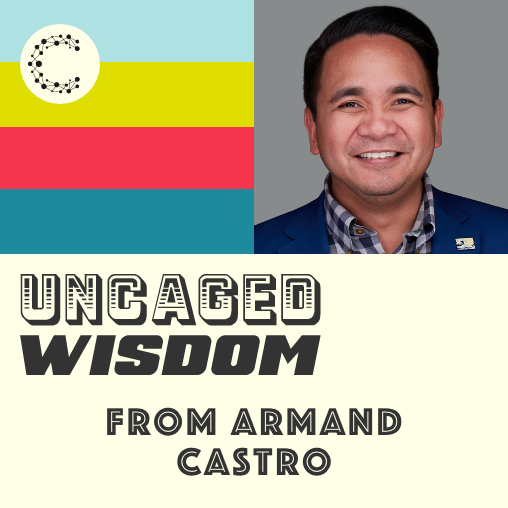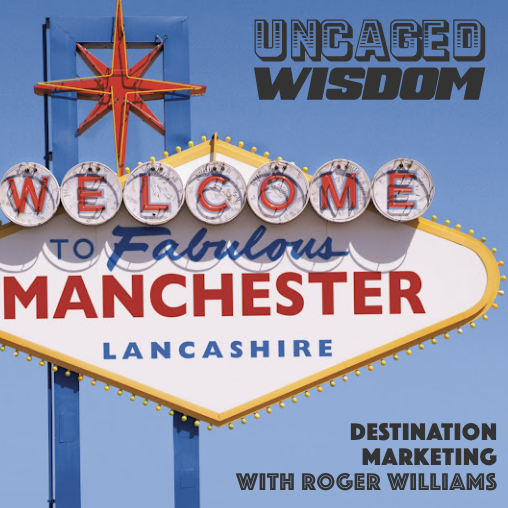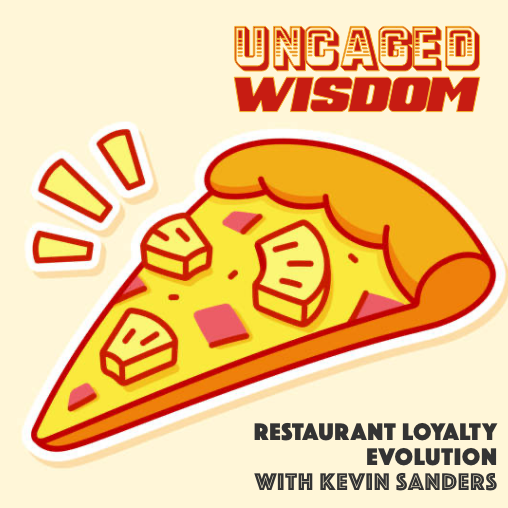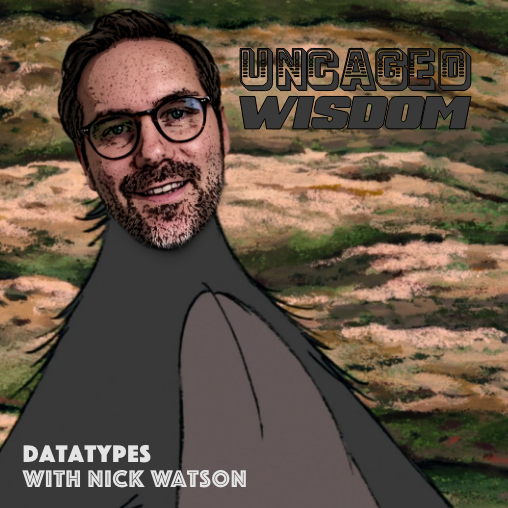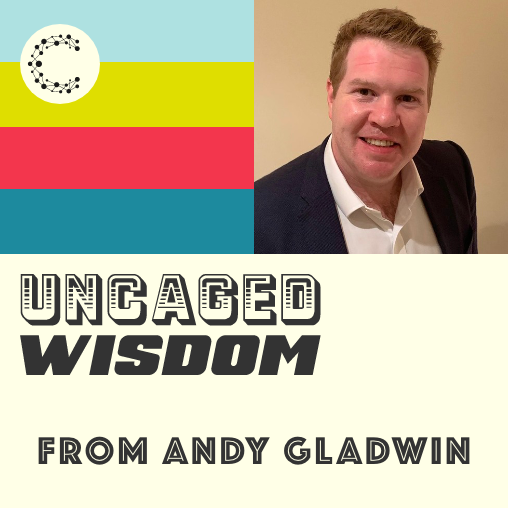The Evolution of Cheetah Digital - CheetahMail to Customer Engagement Suite w/ Armand Castro
- 0.5
- 1
- 1.25
- 1.5
- 1.75
- 2
Julian Bracey-Davis: In this special episode, I don't know what makes it special other than the fact that I've declared it special, getting too big for my boots. We are joined my Armand Castro. Armand is not only a seasoned veteran at Cheetah Digital and current senior solutions consultant. He's also a massive Roger Federer fan and he's going to join Kayla and myself to talk about that evolution of Cheetah Digital from someone who sort of lived the whole journey from bent- over ape to homo erectus. And I actually need to do my research because I can't remember if actually homo erectus is the whole journey of that bent over ape who stood up.
Armand Castro: No, you're halfway there, I think.
Julian Bracey-Davis: You're going to talk to us about what you've seen in terms of changes that you've lived through and the work and the clients you've had to take these changes on, from your early days in the email world right through to today where we've got a whole plethora of glorious items. Let's go back to the beginning, the primeval soup.
Armand Castro: My start in the email game was I guess by happenstance, me noticing in a job of mine that their emails sucked. It was just spammy, all text, words upon words upon words, nothing clickable. It was the most horrendous email you can possibly imagine. Even the prince of Nigeria would probably be like," Ah, I'm deleting this." I went as a temp, as a little 22 year old temp, told them," Hey, you got to fix this. This isn't great." And then they gave me the responsibility.
Julian Bracey-Davis: The power of youth.
Armand Castro: The brazen power of youth. Right. And that's when I just started noticing," Oh, I can use HTML. Oh, you can target on lists and then send out to these people and those people." Right? So little tidbits that slowly grew into," Oh, I can turn this into a career." And at that point I went to a client of ours. And from there I went into CheetahMail. So that's really the initial arc of my entry into email marketing. So it was a very interesting start where didn't know was even a thing, saw how much you could do with it, got a new job because of it and then got drawn into CheetahMail on the, I guess more agency services side.
Julian Bracey-Davis: The key there was CheetahMail. You joined when it was CheetahMail, which for myself, although I'm aware of all of our history, for me, it feels like the foundations of everything.
Armand Castro: I would actually even classify it more specifically. I joined during one of the beginnings, right, because the true beginning was back in 1998, I was in high school. So couldn't possibly have joined then.
Julian Bracey-Davis: Unless when we broke major child labor laws.
Armand Castro: When I joined in 2011, that was kind of the nascent point where Experian was really managing sheet of mail and CheetahMail was the premier product. So that was really focusing and excelling, batch and blast, easy segmentation, list- based, like sending. So we were a powerhouse when it came to that and I understood it based on just the culture within the company where we had all these amazing brands, all these really smart people working together with them and learning about the industry. But yeah, it was really exciting for someone so young as myself, or in Kayla's case, so old as 24, right?
Julian Bracey-Davis: What was the world like at that moment in email marketing?
Armand Castro: Obviously people were slowly getting the value of email marketing. So right off, a lot of people were using just batch and blast, the most basic of basic approaches, right? You just target your entire list and you fire away. Here's the offer for the day. And then we tended to give them maybe some specific paths to take. Maybe you can use dynamic content. These things were revolutionary concepts at the time, like you can do dynamic content, cool. You can do better personalization, you can segment down to specific groups. Those were like," Oh, very cool. We can start really compartmentalizing certain types of folks." Right? So a lot of different clients were at different levels of maturity, but it was overall the entire landscape in terms of the clients I oversaw or worked with, there was just a lot of really early stage understanding of how much more, what more you can get out of email marketing, even on that just list- based approach.
Kayla: For all of our young 19 year old listeners like myself, thank you.
Julian Bracey-Davis: Wow, you're like Benjamin Button. You've decreased in five years on this actual call. By the end of it, you'll just be a sparkle in your parents' eyes. It was Kayla's birthday this weekend. So these age jokes.
Kayla: Looking at when you entered in the email space versus today, what were some of the nuances?
Armand Castro: It's way more developed now, right? People understand how to approach it a lot better. There's still going to be maybe smaller folks that are a little bit simplified in their approach, but it's not like the larger corporations are doing batch and blast much anymore. Right? So the focus is more on maybe understanding how segments of people react to these kinds of offers, understanding a little bit more of the statistics and how it plays out, right? Understanding analytics quite a bit more and how to apply it to strategies. Right? So it's a lot more informed in terms of an approach because it's, at this point, understood that a cudgel isn't the approach here, you got to go with a little bit of precision.
Julian Bracey-Davis: What we're going to do next, we're going to jump through time. I already did some Back to the Future references in the last episode so I'm going to add some more hair because it's free films and I've only done one so far. So that's not a problem.
Doc: All you have to do is drive the time vehicle directly toward that screen, accelerate at 88 miles an hour.
Marty: Wait a minute. Doc, if I drive straight towards the screen, I'm going to crash into those Indians.
Doc: Marty, you're not thinking fourth dimensionally. You'll instantly be transported to 1885 and those Indians won't even be there.
Marty: Right.
Armand Castro: In my mind, that's probably a pretty good initial understanding of just how it was a little Wild Wild West, a little easier to understand how things work. It's just simple list- based.
Julian Bracey-Davis: We discussed a little bit before. What were two moments that really changed the game from your own perspective? And that's why we wanted your version of how the evolution of all this worked. And the first one we discussed is basically the move from flat file to a relational database, which is a lovely sentence. And every time I say it, I feel smarter. Could you talk a little bit more about that moment where we have these list- based approach to suddenly ripping up and going a completely different way?
Armand Castro: Absolutely. So again, in terms of context, I think it's fairly understood at this point that at the time I was really focusing on actually building these campaigns, right? Actually building these segments, actually building these filters. So I had day- to- day experience in supporting these clients of ours in retail, travel, all these different verticals, right? So I was constantly in the weeds, working on these pieces. And around, I think 2011, 2012, one of my clients had decided to move to our new product at the time, a marketing suite, which we now know as Cheetah Messaging. And being that I, as you could tell from my initial foray into email marketing period, like taking on the unknown. I decided I'd want to learn a lot about this new thing. And one of those key facets in terms of the change was relational data, right? So relational data as a concept has existed, right? So it's just rather than a single flat file table, you have multiple tables and establish relationships between each in terms of primary keys and keys across the tables. Right? So simple. But being able to access it and build logic around it within email marketing really blew my mind that I didn't have to have someone run a SQL query to produce a file that I can load onto a flat database. That used to be the process. Right? So if I wanted to look for someone or people who bought$ 50 worth of stuff in the last seven days, if that data isn't already pre- written into the flat file, we need to talk to the client for their CRM, probably come up with a SQL query. They'll spit out a list and then we'll load that and then we'll process it. Now I can use it to target. And that was just the accepted norm. Right? But now, because this data is actually coursing through, I'm getting transactions that I made or Kayla made or you made coursing through and relating to me, I can aggregate within the tool itself. And that was game changing for me because then when my clients would be like," Hey, can we change this and target these folks instead? Instead of$ 50, can I make it$ 70 because I'm not getting the right number?" I can do it on the fly rather than having to ask someone to code it, wait a day, load it. That was just a game changing moment.
Julian Bracey-Davis: Empowering marketers, digital marketers, to do more with the tools that they can access. That's our whole mantra, really. We want to empower them so they can do more and be better at their jobs. So this moment you're describing here is even if it's someone who was like yourself, who was almost acting on their behalf, it was opening up a world of options and possibilities.
Armand Castro: Something where previously, maybe you would be limited in what you could suggest to do because you know that there's underlying work that would need to be done, where now I could be a little bit more adventurous as to who I can target in terms of segmentation, because it's easy to do, right? The easier it was for me to provide these segments or these filters to my client, the more strategic we could get about how to target. Right? So if I understood that the frequency of purchase of a specific fragrance item on a given year is maybe one or two, then maybe I can target categories, frequency, or even specific SKUs, in terms of hitting them with," Hey, time to buy a new bottle." Right? So easy things like that, where previously it would have been a bit of an IT exercise, but now I can just make it a filter logic exercise, just really empowered myself and my clients to be able to do more. And it made me look good. So you got to like that.
Julian Bracey-Davis: That's what we want, is technology makes us look good. That's why we like filters.
Armand Castro: Exactly.
Julian Bracey-Davis: So we can blur ourselves into oblivion.
Kayla: So with how easy things are now that we don't have to depend so much on SQL, can you think back and think of what is the most impactful, yet easy requests that you've received in terms of data filtering for targeting?
Armand Castro: I wouldn't say this is the simplest one, but I thought it was something that would have been challenging for me to do back in the flat file days, would be those product- specific abandoned cart with some exclusions based on maybe what they purchased already. Right? So these are logical pieces where I decide that they, through this abandoned file that came through, they looked at or they added XYZ product. But then since I know that they already bought Z product, I can exclude that because of the filter. So that would have been impressively tough for me to apply that logic or maybe have a SQL query go back to their transaction folks and help me understand who bought what, and then cross reference that onto the abandoned file. So you can imagine how much cross- referencing you'd have to do to establish, okay, now this is what needs to be shown in terms of products.
Kayla: Yeah. I'm thinking about all the different abandoned carts I receive where I may have purchased something that was similar to it, just a different version or a different model, but I'm still getting this," Why aren't you buying this?" Really?
Armand Castro: So you can establish category or SKU, right? So imagine if I, and this is an actual exclusion set I had in a filter, which were if they already made a purchase of this category, I would exclude those products from being visualized. Right? So I can actually apply that logic in a filter that would look at that block of data and prevent that from ever showing up. And it actually made it so easy that maybe my client didn't realize how much harder it used to be. So it was pretty funny that we sometimes now take it for granted, but it's just so much easier for me to do.
Julian Bracey-Davis: The amount of revenue that change would have led to. As Tiger King is the current episode of choice for everyone at the minute, if I'm there browsing my illegal big cat shopping channel, and I've put a cheetah, a lion and a panther in my cage, my shopping cart, my shopping cage cart. And I've decided actually three of those is a bit too many for my zoo, my illegal subterranean zoo right now, I'm just going to buy the panther. A week later or a appropriate time later, someone from the illegal cat cell shop who will be shut down eventually by some sort of a United Nations organization, they've sent me the right triggered email, which is basically said," Are you sure you're not tempted by this offer we now have on cheetahs or lions?" That will then lead to the tipping point for me to make that purchase that I abandoned. We're moving again away from mass marketing, mass mailing, just spamming people on the chance that you get the right moment to making informed decisions and actioning that data to a consequence that we want, we're after, in this case, finishing that purchasing cycle.
Armand Castro: And sometimes it's what the customer wants too, like I might've forgotten that I wanted that thing. Right? And sometimes I actually do want to be reminded. It's not necessarily going to be a cheetah in my cage cart, but I think you get that.
Julian Bracey-Davis: Not a tiger in your tank.
Speaker 6: (singing)
Kayla: Too bad. It's too bad.
Julian Bracey-Davis: We hop to on next, our second moment of inspiration I guess you could call it an aha moment. A crystallization of the future and the direction Cheetah was going in.
Armand Castro: I like to read every bottle.
Julian Bracey-Davis: What are we saying for this next moment I'm on? We sort of set it up by saying the first one was this move from flat file to relational databases. That then opened up not just a whole world of messaging and the way that we could communicate to clients cross channel, it spiraled into what we've currently got, customer engagement suites, this set of softwares that on the face of it could look separate, but they're really not because they can all be joined together. And they are united by the central beast, the engagement data platform.
Armand Castro: Exactly.
Julian Bracey-Davis: Which ties nicely back to the way that we handle them versus data now. And we have these different sets of cross channel messaging. We have our loyalty suite and we have experiences. But how do we get there? How did that happen from this moment of a relational database to having a suite of tools that really, really are powerful for any digital marketer to make the difference in their organization?
Armand Castro: Obviously it's always been the case that when change occurs, there's always going to be a little bit of feeling through what's going on, how is this going to work, that idea of uncertainty a little bit in the face of change, right? So at the time, obviously we've had gotten to a point where we were very comfortable with the relational tables, the cross- channel messaging capabilities of just marketing suite or Cheetah Messaging. But the core idea of it in terms of what it was driving to was really trying to promote a level of loyalty with your customers, right? You're trying to build a relationship through those communications and really it serves towards customer loyalty. If you're providing me the right kind of targeted experience, because you're using my data correctly, I'm going to respond because you're giving me the right offers and the right things that I wanted to see. And that initial acquisition of a loyalty solution was at first like, all right, that seems like an entire other business to us. But in hindsight, when you take a step back, it's really just another more focused mechanic that's driving again, towards loyalty. It's just that it's more blatant in terms of what it does. It's really loyalty, quote, unquote focused. But everything we did even back in the CheetahMail days was to try to create a level of customer loyalty because engagement, re- engagement, purchasing and repurchasing and advocating for a brand is loyalty, simply put. So that's when it was beginning to dawn on me," Okay, that was a logical move." We got into loyalty and that's going to help us really have these mechanics that really are in support of and maybe worked well together with what channel messaging can do. Right? And then from there, it was really understanding that if we had all of that data in a central core, like all the beginnings of a rumblings of CDP, because that's what we really had with the relational tables, right? Easy access to better data and better activities in one place to activate across channels. But if you applied it to a broader scale, if we looked at all that advanced and more modern architecture that's powering loyalty at the time and now, can we use that to be the engine, the data engine, that really drives cross- channel messaging and loyalty? And those initial thoughts were like," Oh, okay. That could be an approach." If you have like this modern architecture, the likes of Uber, all of them that are using today. If we use that kind of the data architecture to power our messaging and loyalty, that would be pretty cool. But obviously earlier on, it was a bit more conceptual, right? So it was still kind of crystallizing into shape. And then you bring in, what was this last year, Experiences. And then again, I'm like," All right, they bring more data in, I guess that absolutely made sense." Right? But where does it all fit? And then once that first time that we saw that EDP nucleus with the different spokes of experiences, loyalty and messaging, small tangent, but that is actually a very weird fact about me, I was a pre- med bio major.
Julian Bracey-Davis: You chucked it all the way for this. I'm a philosophy major, so we've all made some questionable life choices, I mean good life choices.
Armand Castro: But if you think about it, a lot of science in terms of a scientific approach does apply to what we do, right?
Julian Bracey-Davis: Yeah, absolutely.
Armand Castro: So it's all about hypothesizing whether if you do this, will it yield this, and then you come up with a game plan, you use the data, right? So it's a matter of what I have at my disposal to be able to do it.
Julian Bracey-Davis: Yep.
Armand Castro: And what we have at our disposal today is very robust in terms of what I can do. And I find myself a lot more excited as we keep making a lot of this progress in terms of beefing up our product, right? Because again, coming back to kind of that first time I saw the visualization of Experiences allowing you to better collect, better acquire and better constantly understand your customers, Messaging allowing you, again with the same data core, a means to interact or at least talk to your customers, loyalty mechanics, as a means to reward or provide an infrastructure to encourage types of behaviors.
Julian Bracey-Davis: Emotional loyalty, man.
Armand Castro: Right.
Julian Bracey-Davis: Go get the feels. That's what we want, isn't it?
Armand Castro: Yeah. It's exactly, that's when it really started clicking that this is really an evolution from when we were just looking at how easy it was to access relational data in the marketing suite to now I'm actually able to activate that data across messaging, leverage it within loyalty and improve upon it, constantly be able to develop that data about the likes of you, the likes of me with experiences, because I think your experiences might initially be an easy way to acquire, but it's a constant acquisition.
Julian Bracey-Davis: Yes. I completely agree. It's the re- engagement and the constant acquisition is the second pillar of what makes it so powerful. Obviously, the acquisition data, it helps. But it's that re- engagement piece because what are we all? We are all changing. This whole tedious subject matter of a theme that I applied to our podcast today was evolution, which is of course change over time. That applies to our own lives and the customers' lives. We're going from being single and ready to mingle in a New York flat to married with kids in a blink of an eye. And the chances are many of the brands you're using then will be still the same brands you'll be with further down the line. Just the differences, the consumer habits, what you will need from and what you expect from the way that a brand talks to you. Because if it really knows you, and we're trying to preach brands having relationships with their customers, then it needs to be a personalized relationship, it needs to have an element of understanding. And of course we're all changing. So this, going back to experiences and that re- engagement, it helps you, along with loyalty, understand the journey that people want.
Armand Castro: It's the difference between assuming some possibility to being certain about it because I asked, right? So it's like looking outside and seeing it's sunny, assuming it's warm, but it's not because it's winter. Right? So there's certain things where you'd rather actually obtain the facts, either by asking or by checking with the likes of a customer and understanding their actual current state. It's not always just about a pattern of behavior. That's definitely always going to be a valuable aspect of the data. But if you, with certainty, know that this is now their current state because they said so, that holds supreme value over assumption. Right off the bat, so valuable about what we've done in terms of unifying this CES, the customer education suite, and actually having that data activated across those different solutions. It really is lending itself to building a relationship in a much better sense of the word with their customers, right? Because what is a relationship, if not discourse, right? So it's not a one- way street if it's a relationship. So it has to be two ways, right? So it's not always just about, here's five bucks, here's five bucks, here's 15%. It has to be," Hey, are you interested in this? You expressed this before, can I be sure?" Right? That's all you're doing, is making a real relationship with your customers and reacting to it appropriately. But there's always going to be cases where you notice a pattern of behavior and then you can make assumptions from that. That doesn't take that away, and the relationship that exists too. So I think it's just logical in terms of what we're doing.
Julian Bracey-Davis: Kayla, you normally have something to spring on people, don't you?
Kayla: I do. I do. So everyone has their inaudible, so they're super passionate about a subject.
Armand Castro: Roger Federer would be one of those things that I can talk for hours about, considering I've liked and watched tennis with my mom since I was maybe six, seven years old. And this is all the way in the Philippines, so it's like little grainy videos of Pete Sampras back when I was a little kid and Andre Agassi. And the only Asian that I watched, Michael Chang, so I got excited by that. And then when I first moved to the US in'98,'99, seeing the up- and- comers slowly shift from Pete Sampras and then watching this kid, at the time, and around 2000, 2001 I think, beat Pete Sampras at Wimbledon.
Julian Bracey-Davis: Changing of the guard moment. I remember it well.
Armand Castro: And that blew my mind because I was such a huge Pete Sampras fan and this little pimply faced Swiss guy beat him, pretty handily too. It wasn't too tight. The guy was just really good. I was like," Holy crap, who is this kid?" So I started actually following this guy's career back in'01 and I was just blown away by how good he was, and have been very much of a passionate fan of his since then. I've watched him in quite a few tournaments, including one in Switzerland, because that's where my sister lives.
Announcer: The fourth round of the men's singles at Wimbledon in 2001 pitted two of the greatest exponents of the game against each other in what would be their only competitive match. At 29 years of age, America's Pete Sampras was the number one seed and aiming to become the first man ever to win eight Wimbledon singles titles. Roger Federer was only 19 and seeded 15th. The Swiss was a former junior Wimbledon champion with huge potential, but it was his first appearance in the fourth round and his first appearance on center court. On paper, it was difficult to see how he could put a stop to Sampras's 31 match winning streak.
DESCRIPTION
1:35 to 6:35 - Armand discusses how he ended up in the world of email marketing and ultimately working for CheetahMail.
7:35 to 16:34 - Moment of Inspiration / A-HA! #1 - Cheetah’s move from a flat file to a relational database (CheetahMail to Messaging) and how it helped Armand better support his clients by offering more. Resource.
16:50 to 27:45 - Moment of Inspiration / A-HA! #2 - The Customer Engagement Suite. Armand takes us through how all the components of the CES - Messaging, Loyalty, and Experiences, all came together around the Engagement Data platform.
27:58 to 30:33 - An ode to the GOAT that is Roger Federer.

